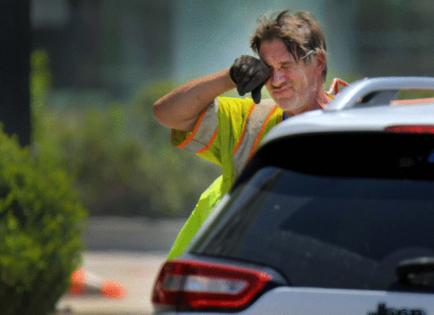Extreme heat tests Maryland's new workplace regulations
Published in Weather News
BALTIMORE — As the heat index soars above 100 degrees in the Baltimore region this week, officials are urging workplaces to follow new state regulations for managing high-heat environments in the workplace to avoid heat-induced illness.
“This is going to be potentially an increasing risk for workers on the job,” Maryland Labor Secretary Portia Wu said. “We want to help them comply, we all benefit from making sure that workplaces are safer.”
In late September, Maryland’s Heat Stress Standards took effect, requiring workplaces to create, share and follow written policies for keeping workers safe when the “heat index” — what the air temperature and humidity combined feels like — is higher than 80 degrees in indoor or outdoor workplaces.
Maryland is the first East Coast state with such standards, but one union official told The Baltimore Sun that many employers do not know about the regulation. And representatives from two industry groups told The Sun that they find the law too broad.
It enables the Maryland Occupational Safety and Health program, which is under the Maryland Department of Labor, to exceed federal Occupational Safety and Health Standards, which do not include heat protections. Twenty other states and one territory have similar programs.
While the heat standards had been in the works for years, they came a month too late to help Baltimore City Department of Public Works employee Ronald Silver II. Silver, a 36-year-old trash collector, died of hyperthermia, according to the Maryland Medical Examiner’s Office, after collapsing while working in extreme heat last August. His death was among 27 heat-related deaths in Maryland last year, workplace or otherwise — a six-year high, according to the Maryland Department of Health.
The city’s public works department has since made a Heat Illness Prevention Plan in accordance with the state’s Heat Stress Standards. The department said in a statement to The Sun that it “remains committed to the consistent implementation of these safety measures to protect our workforce and uphold a healthy, responsive work environment.”
What the regulation requires
Maryland requires employers to give workers who are exposed to a heat index above 90 degrees at least 10 minutes of rest for every 2 hours of work. This is upped to a break of at least 15 minutes every hour when the heat index exceeds 100. When the heat index is above 80, workplaces are required to provide cool water and shade for their employees.
Because workplace heat deaths disproportionately occur during an employee’s first week, when an employee is exposed to high heat levels for the first time or after more than seven consecutive days without being in a work environment with a heat index over 80, employers are required to monitor that employee, such as via radio or a buddy system, for signs of heat stress.
Maryland’s standards also require employers to have a written plan for how they will handle heat and train employees about signs of heat stress before their first day working in high-heat environments, annually before warm weather returns and after any confirmed heat-related illness. Employers must also monitor the heat index for all of their indoor and outdoor workplaces.
The law does not apply to workers responding to an emergency, employees required to work less than 15 minutes in an hour in high heat, or to employees in trucks or buildings with ventilation systems that keep the heat index below 80 degrees.
‘Working until it’s too late’
Heat-induced illness can cause heat rash, fainting, heatstroke and death. However, Kate McPhaul, an associate professor and researcher of occupational health at the University of Maryland, said even less severe effects can harm employees’ health and ability to work. Employees may feel lethargic, dizzy and tired, McPhaul said, which can cause long-term health impacts such as strain on workers’ hearts and kidneys.
“People will keep working until it’s too late,” McPhaul said. “Employers and their coworkers really have to find ways to get people to pull back in these really hot situations.”
Maryland’s Heat Stress Standards, McPhaul said, give workers permission to take care of themselves and their coworkers in the heat.
Wu, the state’s secretary of labor, told The Sun that the department is focusing on educating stakeholders. Outreach has included a webinar, sharing template plans and consulting small businesses.
“Often employers don’t know that they have an obligation at all under the law,” Wu said. “Our first goal is compliance.”
‘Speak up’ for enforcement
Employees are encouraged to tell their employer if they think their workplace isn’t following the standards, then to complete an online complaint form with Maryland Occupational Safety and Health if violations persist.
Upon receiving a report, Wu said, the labor department will explain the standards to the employer. If a serious incident occurs, she said, there would be an investigation. Violating state occupational health standards can lead to citations or civil penalties for private sector employers.
Denise Gilmore, the legislative director for AFSCME Maryland Council 3, which represents state, municipal and county employees in Maryland, said the majority of employers the union has met with regarding heat regulations haven’t followed the training requirements and acclimatization standards. Gilmore said they are hoping the state takes a proactive stance to lead the way as a top employer and by enforcing the standards.
“Employees now have these new rights, they only get enforced if people know their rights and speak up if they’re being violated,” Gilmore said.
‘Unrealistic and unattainable’ standards
Tyler Hough, legislative director for the Maryland Farm Bureau, said the organization considers safety a top priority but views the standards as “almost unrealistic and unattainable for farmers.”
The group representing Maryland farmers believes frequent breaks can conflict with the narrow windows they have to pick certain crops, said Hough, who added that many employers provided workers shade and water before the regulation.
Cailey Locklair, the president of the Maryland Retailers Alliance, said the heat standards are “a one-size fits all mandate that doesn’t work for all businesses.” She worries that indoor businesses could be penalized if their HVAC system breaks or if employees have to go outside briefly.
While the Trump administration has been seeking to cut many regulations, last week the national Operational Safety and Health Administration held hearings about a proposed federal regulation with requirements similar to the Maryland standard.
---------
©2025 The Baltimore Sun. Visit at baltimoresun.com. Distributed by Tribune Content Agency, LLC.







Comments